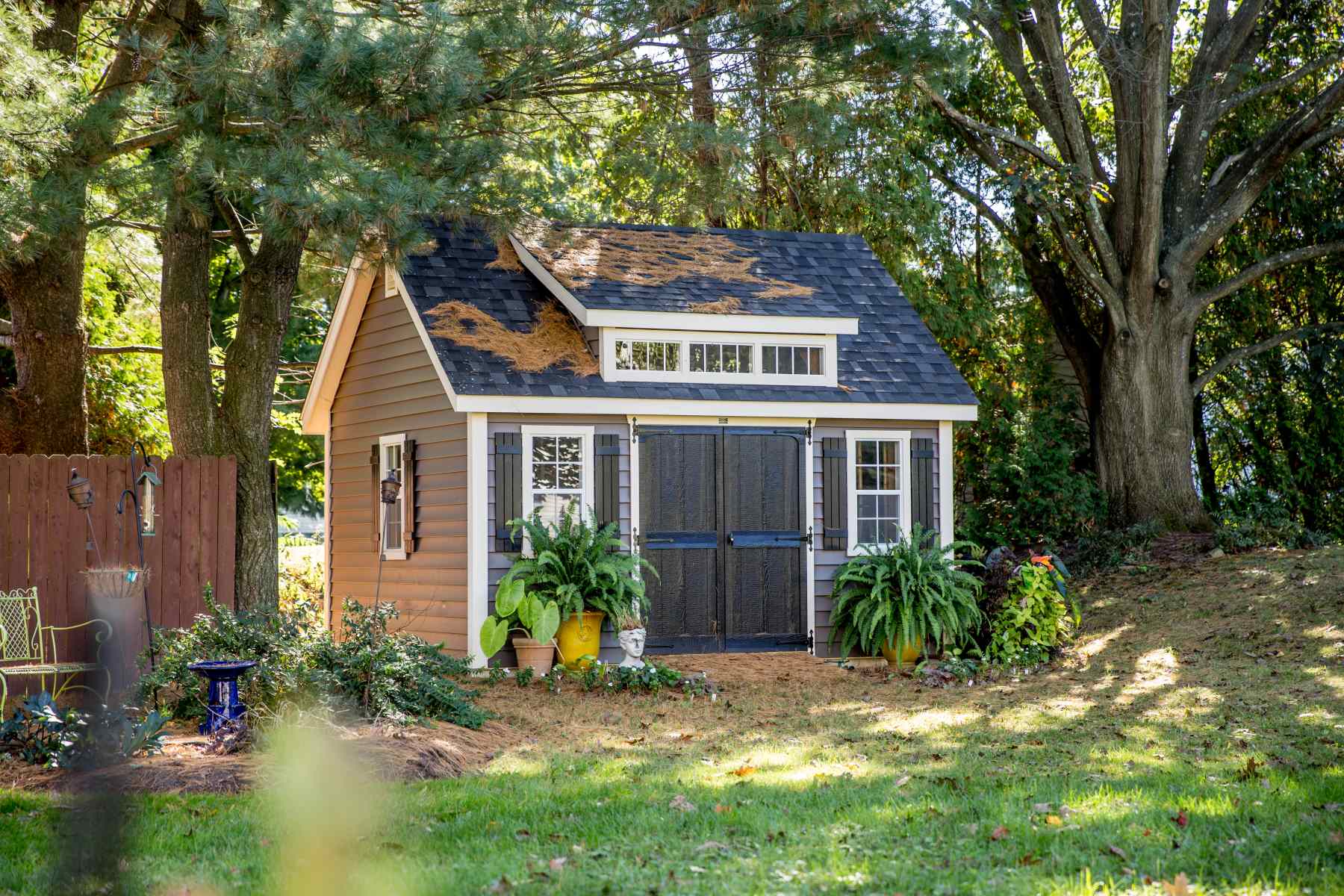Home>Real Estate>Build A House On Your Land Without Permits Or Permission – No Rules, No Limits!


Real Estate
Build A House On Your Land Without Permits Or Permission – No Rules, No Limits!
Published: February 15, 2024
Discover how to bypass permits and regulations to build your dream home on your land. Explore real estate opportunities with no limits or rules.
(Many of the links in this article redirect to a specific reviewed product. Your purchase of these products through affiliate links helps to generate commission for Regretless.com, at no extra cost. Learn more)
Table of Contents
Introduction
So, you've always dreamt of building your own house, a place where you can truly call home. But what if you could do it without the hassle of permits and regulations? What if you could construct your dream home on your own land, without having to seek permission from local authorities? It sounds like a tempting proposition, doesn't it? The idea of being free from the constraints of building codes and zoning laws might seem like a dream come true for many aspiring homeowners.
However, before you grab your tools and start laying the foundation, it's important to understand the risks and consequences of embarking on such a venture. Building a house without permits or permission is a bold and unconventional move that comes with its own set of challenges and potential repercussions. While the thought of bypassing bureaucratic red tape is alluring, it's essential to weigh the pros and cons before diving headfirst into this uncharted territory.
In this article, we'll delve into the intricacies of constructing a house without the necessary permits and explore the implications of such a decision. From finding the right location to navigating the construction process and ultimately living in your unpermitted house, we'll guide you through the unconventional journey of building a home on your own terms. So, fasten your seatbelt and get ready to explore the uncharted territory of unpermitted home construction.
Understanding the Risks and Consequences
Embarking on the endeavor to build a house on your land without obtaining the necessary permits and permissions is a decision fraught with potential risks and consequences. While the idea of circumventing bureaucratic hurdles may seem liberating, it's crucial to comprehend the implications of such a choice.
Legal Ramifications
Constructing a house without the mandated permits and approvals can lead to severe legal repercussions. Local authorities enforce building codes and zoning regulations to ensure the safety and well-being of inhabitants. By sidestepping these regulations, you could face fines, legal injunctions, and even demolition orders for your unpermitted structure. This could result in significant financial losses and legal entanglements that may far outweigh the initial allure of avoiding red tape.
Safety Concerns
Building codes exist to uphold structural integrity and safety standards. Without adhering to these regulations, your home may be at risk of structural deficiencies, electrical hazards, and fire safety issues. Moreover, the absence of inspections and oversight means that potential hazards could go unnoticed, posing a threat to the well-being of occupants. In the event of an accident or disaster, insurance coverage may be compromised, leaving you vulnerable to significant liabilities.
Property Valuation and Resale
An unpermitted house may encounter challenges in terms of property valuation and resale potential. Prospective buyers are likely to be deterred by the legal uncertainties and potential liabilities associated with an unpermitted structure. This can significantly diminish the market value of the property and limit your options when it comes to selling or refinancing the home.
Community Relations
Building without permits can strain relationships with neighbors and the local community. Your actions may be perceived as disregarding communal norms and regulations, leading to conflicts and strained interactions with neighbors and local authorities. This could result in a loss of goodwill and community support, which is crucial for a harmonious living environment.
In essence, while the allure of building without permits may initially seem appealing, the risks and consequences associated with such a decision are substantial. It's essential to carefully consider these factors before proceeding with unpermitted construction, as the potential ramifications can have long-lasting implications for both the property and its occupants.
Finding the Right Location
Selecting the ideal location for building an unpermitted house is a pivotal decision that warrants careful consideration. While the allure of constructing a home without regulatory constraints may prompt thoughts of building in secluded or unconventional areas, it's essential to approach this decision thoughtfully.
Assessing the Legal Landscape
Before embarking on the search for the perfect location, it's crucial to gain a comprehensive understanding of local zoning laws and building regulations. While the intent is to bypass these regulations, being well-informed about the legal framework will enable you to make informed decisions. Certain areas may have more lenient regulations or be less stringent in enforcing building codes, making them more conducive to unpermitted construction. However, it's imperative to proceed with caution and conduct thorough research to minimize the risk of legal entanglements.
Remote vs. Urban Settings
The choice between a remote or urban setting for your unpermitted house entails a careful evaluation of the advantages and drawbacks of each. Remote locations may offer greater privacy and freedom from close scrutiny, but access to essential utilities and services could be limited. On the other hand, urban settings provide proximity to amenities and infrastructure but may also entail heightened scrutiny and enforcement of building regulations. Balancing these considerations is crucial in determining the most suitable location for your unpermitted home.
Read more: When Time Permits: Unleash Your Creativity!
Environmental Factors
Consideration of environmental factors is paramount when selecting a location for unpermitted construction. Assessing the topography, soil composition, and natural surroundings is essential to ensure the feasibility and sustainability of building in a particular area. Additionally, factors such as access to water sources, solar orientation, and environmental impact should be taken into account to optimize the livability and functionality of the unpermitted house.
Community Dynamics
Understanding the dynamics of the local community is integral to the decision-making process. Building an unpermitted house can potentially affect relationships with neighbors and the community at large. Engaging in open dialogue with neighbors and gauging the community's disposition towards unorthodox construction can provide valuable insights into potential challenges and opportunities in your chosen location.
In essence, finding the right location for building an unpermitted house involves a comprehensive assessment of legal, environmental, and communal factors. By carefully navigating these considerations, you can identify a location that aligns with your vision while minimizing potential risks and challenges associated with unpermitted construction.
Building Your House
Constructing a house without the necessary permits and permissions presents a unique set of challenges and considerations. As you embark on the journey of building your unpermitted house, several key aspects demand meticulous attention to ensure the successful realization of your vision.
Design and Construction
The design phase of your unpermitted house holds paramount significance, as it sets the foundation for the entire construction process. Embracing innovative and sustainable design principles can enhance the functionality and livability of your home while aligning with your vision of a unique and personalized living space. Engaging with experienced architects and designers who understand the nuances of unpermitted construction can be invaluable in translating your ideas into a practical and structurally sound design.
When it comes to construction, meticulous attention to detail is imperative. While you may not be bound by conventional building codes, prioritizing structural integrity and safety remains non-negotiable. Engaging skilled and reputable contractors who are well-versed in unorthodox construction practices can ensure that your vision is translated into a robust and well-executed structure.
Material Selection and Sustainability
Opting for sustainable and locally-sourced materials can not only align with eco-conscious principles but also contribute to the resilience and longevity of your unpermitted house. Exploring alternative building materials and construction techniques can offer unique aesthetic appeal while minimizing the environmental impact of your project. Additionally, integrating energy-efficient systems and sustainable technologies can enhance the self-sufficiency and eco-friendliness of your unpermitted home, aligning with modern sustainability trends.
Off-Grid Living Considerations
The prospect of building an unpermitted house often coincides with the desire for off-grid living. Embracing off-grid solutions such as solar power, rainwater harvesting, and composting toilets can foster self-sufficiency and reduce reliance on conventional utilities. However, careful planning and consideration of local regulations, environmental impact, and long-term maintenance are essential in implementing off-grid systems effectively.
Adhering to Safety Standards
While unpermitted construction affords a degree of freedom from regulatory oversight, prioritizing safety measures is crucial. Implementing robust fire safety measures, electrical standards, and structural stability is essential to safeguard the well-being of occupants and mitigate potential hazards. Engaging with professionals to conduct independent safety assessments can provide valuable insights and ensure that your unpermitted house upholds essential safety standards.
In essence, building your unpermitted house demands a harmonious blend of creativity, practicality, and adherence to essential safety and sustainability principles. By approaching the construction process with meticulous planning and a commitment to excellence, you can transform your unconventional vision into a tangible and livable reality.
Living in Your Unpermitted House
Living in an unpermitted house entails a unique lifestyle characterized by autonomy, self-sufficiency, and a distinct sense of individuality. As you settle into your unconventional abode, several key aspects define the experience of residing in a home that defies traditional regulatory norms.
Read more: “When Time Permits” Definition And Meaning
Self-Reliance and Autonomy
Embracing the lifestyle of living in an unpermitted house fosters a profound sense of self-reliance and autonomy. From managing off-grid utilities to implementing innovative solutions for daily living, occupants of unpermitted houses often find themselves embracing a hands-on approach to sustaining their living environment. This self-reliant ethos can cultivate a deep sense of empowerment and resourcefulness, as occupants navigate the nuances of living without the conventional infrastructure and oversight.
Community Dynamics and Perception
Living in an unpermitted house can influence the dynamics of your relationship with the local community. Nurturing open communication and fostering positive interactions with neighbors can mitigate potential conflicts arising from the unconventional nature of your dwelling. Engaging in community initiatives and demonstrating a commitment to responsible and conscientious living can contribute to a harmonious coexistence within the neighborhood, fostering mutual respect and understanding.
Legal Considerations and Vigilance
Navigating the legal landscape as a resident of an unpermitted house necessitates vigilance and awareness of potential ramifications. While the allure of bypassing bureaucratic constraints may initially seem liberating, remaining cognizant of legal developments and proactively addressing any compliance-related concerns is crucial. Staying informed about local regulations and seeking legal counsel, if necessary, can provide clarity and mitigate the risk of legal entanglements.
Resilience and Adaptability
The experience of living in an unpermitted house often demands resilience and adaptability. Overcoming challenges associated with unconventional living, such as managing off-grid utilities, addressing maintenance needs, and mitigating potential regulatory scrutiny, requires a resilient mindset. Embracing innovative solutions and remaining adaptable in the face of unforeseen circumstances can foster a sense of empowerment and self-assurance in navigating the intricacies of unpermitted living.
Read more: 5 Signs That A Jinn Is Haunting Your House
Personalized Living Environment
One of the defining aspects of residing in an unpermitted house is the opportunity to curate a personalized and unique living environment. From implementing creative design elements to embracing sustainable living practices, occupants of unpermitted houses have the freedom to shape their living space in alignment with their individual preferences and values. This personalized approach fosters a deep sense of ownership and connection to the living space, creating a truly distinctive and personalized sanctuary.
In essence, living in an unpermitted house transcends the conventional norms of homeownership, offering a lifestyle characterized by self-reliance, adaptability, and the freedom to create a personalized living environment. While navigating the nuances of unpermitted living presents its own set of challenges, embracing this unconventional path can lead to a deeply fulfilling and uniquely individualistic living experience.
Conclusion
In the realm of real estate and homeownership, the concept of building a house on your land without permits or permission represents a bold departure from conventional norms. The allure of circumventing bureaucratic red tape and embracing unbridled freedom in constructing a personalized dwelling may initially seem enticing. However, the journey of unpermitted home construction is laden with complexities, risks, and potential consequences that warrant thoughtful consideration.
As we navigate the uncharted territory of unpermitted home construction, it becomes evident that the decision to pursue this unconventional path carries multifaceted implications. From legal ramifications and safety concerns to community dynamics and the unique experience of living in an unpermitted house, the intricacies of this endeavor underscore the gravity of the decision.
The risks and consequences associated with building without permits are substantial and far-reaching. Legal entanglements, safety hazards, and challenges in property valuation and resale potential loom as formidable deterrents. Furthermore, the impact on community relations and the potential strain on neighborhood dynamics underscore the broader implications of unpermitted construction.
Finding the right location for unpermitted construction demands a nuanced approach, balancing legal considerations, environmental factors, and community dynamics. The choice between remote and urban settings, coupled with an understanding of local zoning laws, lays the foundation for a well-informed decision that minimizes potential risks and challenges.
Embarking on the construction of an unpermitted house necessitates a meticulous approach, emphasizing innovative design, sustainable construction practices, and a commitment to safety standards. The integration of off-grid living considerations and a steadfast focus on structural integrity and sustainability underscores the conscientious approach required in realizing the vision of an unpermitted home.
Living in an unpermitted house embodies a lifestyle characterized by self-reliance, resilience, and a personalized living environment. The experience of navigating legal considerations, fostering community relations, and embracing the autonomy of unpermitted living underscores the multifaceted nature of this unconventional homeownership journey.
In essence, the decision to build a house on your land without permits or permission transcends the realm of conventional homeownership, offering a path characterized by autonomy, self-reliance, and the freedom to curate a truly unique living space. However, the gravity of this decision necessitates a comprehensive understanding of the risks and consequences, thoughtful consideration of the location, and a meticulous approach to construction and living in an unpermitted house. Ultimately, the journey of unpermitted home construction embodies a paradigm shift in homeownership, redefining the boundaries of personal autonomy and individualistic living.










